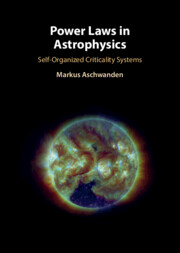Book contents
- Frontmatter
- Dedication
- Contents
- Foreword
- Preface
- Abbreviations
- Part I Fundamentals of SOC
- Part II Astrophysical SOC Phenomena
- 4 Solar Flare Hard X-Rays
- 5 Solar Flare Soft X-Rays
- 6 Solar EUV Nanoflares
- 7 Solar Photospheric Events
- 8 Solar Radio Bursts
- 9 Coronal Mass Ejections
- 10 Solar Energetic Particle Events
- 11 Solar Wind
- 12 Magnetospheric Phenomena
- 13 Planetary Systems
- 14 Stellar Systems
- 15 Galactic and Black-Hole Systems
- Part III Conclusions
- References
- Index
4 - Solar Flare Hard X-Rays
from Part II - Astrophysical SOC Phenomena
Published online by Cambridge University Press: 05 December 2024
- Frontmatter
- Dedication
- Contents
- Foreword
- Preface
- Abbreviations
- Part I Fundamentals of SOC
- Part II Astrophysical SOC Phenomena
- 4 Solar Flare Hard X-Rays
- 5 Solar Flare Soft X-Rays
- 6 Solar EUV Nanoflares
- 7 Solar Photospheric Events
- 8 Solar Radio Bursts
- 9 Coronal Mass Ejections
- 10 Solar Energetic Particle Events
- 11 Solar Wind
- 12 Magnetospheric Phenomena
- 13 Planetary Systems
- 14 Stellar Systems
- 15 Galactic and Black-Hole Systems
- Part III Conclusions
- References
- Index
Summary
Solar flare hard X-ray events are produced by the electron thick-target bremsstrahlung process at electron energies of ~20 keV. Large statistical samples of hard X-ray fluxes, fluences, energies, flare durations, and waiting times have been observed with instruments from three different spacecraft (HXRBS/SMM, BATSE/CGRO, and RHESSI) from three different solar cycles and analyzed with different automated event detection methods. Despite of this large variety of data, all datasets reveal self-consistent results, for instance, power law peak fluxes with a slope of , which match the theoretical prediction of the fractal-diffusive SOC model, that is, . Systematic errors and uncertainties of these datasets include insufficient fitting ranges, spacecraft orbital data gaps, finite-size effects, south Atlantic anomaly data gaps, instrumental sensitivity, incomplete samples, thresholded event selection, and background subtraction.
Keywords
- Type
- Chapter
- Information
- Power Laws in AstrophysicsSelf-Organized Criticality Systems, pp. 61 - 71Publisher: Cambridge University PressPrint publication year: 2024

